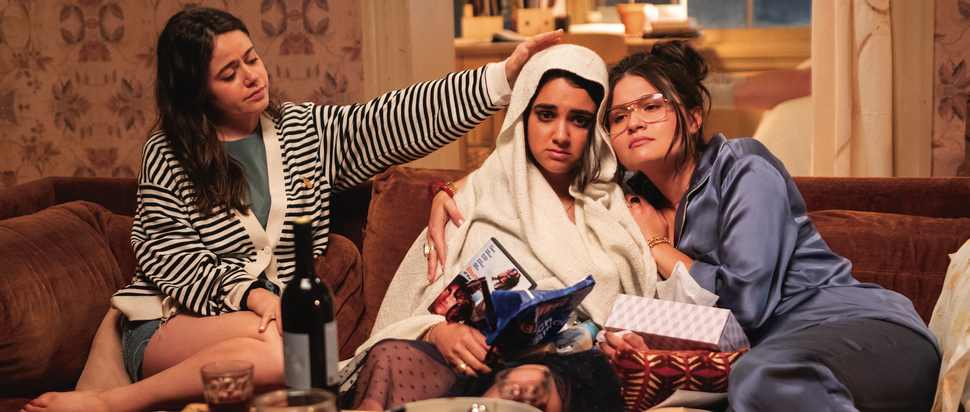Natalie Krinsky on The Broken Hearts Gallery
The mores of the Hollywood romantic comedy get a welcome upgrade with the irresistibly charming The Broken Hearts Gallery. Its writer-director, Natalie Krinsky, explains how her vivacious debut both embraces and subverts the genre
“Given everything that’s been happening in the world, there's something nice about the elixir of a romantic comedy,” Natalie Krinsky says thoughtfully. Looking at the trainwreck of 2020, it’s hard to argue. Her directorial debut The Broken Hearts Gallery certainly feels like a tonic; released here in the UK during that tiny window in the summer when cinemas were open, it’s now getting a larger and much-deserved audience through streaming this month.
Warm, vivacious and irresistibly charming, it follows Lucy (Geraldine Viswanathan), a gallery assistant who, after losing both her job and boyfriend, teams up with handsome stranger Nick (Dacre Montgomery) to create a gallery space dedicated to the paraphernalia left over from broken relationships. Krinsky’s film – which she wrote over the course of a decade – captures all the requisite dreamy, swoony feelings the best romantic comedies should give, with an unexpected twist: heartbreak is woven deep into every scene.
“I think one of the things that I experienced in my own life is the isolating nature of heartbreak,” Krinsky explains about her unusual approach. “You feel as if you're the only person in the world who has ever experienced the depths of pain and despair when it's happening to you. The discovery of its universality is part of [Lucy’s] journey and is part of her healing. It’s truly a rite of passage. I think that in order to become an adult, you need to experience heartbreak. Heartbreak and puberty,” she laughs.
Constructing a romance predicated on breaking up is no mean feat, but it is one of the many ways in which The Broken Hearts Gallery both unabashedly participates in and cleverly subverts the genre’s tropes, treading the line between earnestness and wry cynicism with impressive delicacy. “In the late 90s and the early 2000s, romantic comedies followed a certain formula and people got tired of them,” Krinsky says. “[But] a lot of things have evolved. I think there's room for all different kinds of people to fall in love. I don't think you need to be a 100-pound blonde waif in order to find happiness.”
It’s not just about the diverse casting, although that plays a large part in opening up the dynamic possibilities of the genre. “We leant into a lot of the big romantic comedy tropes,” Krinsky says. “But I think that we also did a lot of things differently. I think there is a real feminist power in the film; part of Lucy’s journey is staking her own professional claim in the world and pursuing an idea that she has and finding her voice and building something for herself.”
In doing so, Krinsky allows Lucy an agency that lies beyond mere romantic fulfilment, complicating the received idea of what happiness looks like for women in these films. Outside of her blossoming relationship with Nick (who is genuinely kind and supportive), Lucy’s life is grounded by her close female friends and their shared home, giving her the kind of complex interior life typically denied to rom-com heroines. “Through all the drafts there was always the three of them,” Krinsky says. “They were very much inspired by my own friendships in my 20s. They're really enduring: I think especially when you're a transplant in a city, and you don't necessarily have family close by, your female friends truly do become the people that you go home to.”
They might feel like small changes, but they have a seismic effect; not just on the audience’s viewing experience, but on the film’s own attitude to its female lead – an attitude rooted in empathy rather than the scorn or derision characteristic of the genre’s unkinder entries. There is a determined compassion throughout The Broken Hearts Gallery that feels indicative of a wider shift within the genre, a move away from the singular narratives and paternalistic voices that once dominated the landscape.
It's not just on screen that Krinsky is flipping the script and doing things differently. “I have never loved anything more than directing this film. My husband came to visit me and he still to this day says that it's the happiest he's ever seen me, including our wedding day,” she laughs. “The way all of these different people came together to make something happen that you thought of in your brain is really magical. There’s long been this myth of the male director auteur that has captivated Hollywood, this myth that you have to be tough and mean, and I just don't think that's true. All kinds of different people who have had all kinds of different experiences can do this, and can show that there's a myriad of ways to lead a team. There's a myriad of ways to direct a movie. And there's a myriad of different voices that we need to have”.
The Broken Hearts Gallery is available to download now, and is released on DVD 18 Jan from Sony Pictures
